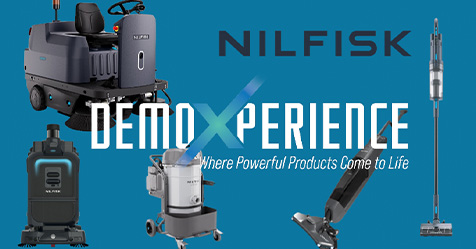Walking through Chicago’s Midway Airport at 1:00 a.m., you may not see many people.
What you will see are a lot of automatic scrubbers.
At that time in the morning, cleaning crews block off entire areas of the airport in order to clean the floors using these machines.
Seeing all those “autoscrubbers,” as they are frequently called, you have to wonder how custodial workers cleaned large floor spaces such as those found in airports decades ago.
After all, when were automatic scrubbers first invented?
The answer to the first question is easy.
Before the invention of these machines, floors in airports, train stations and other large facilities were dust mopped and then cleaned using mops and buckets.
It was slow, tedious work, and the results were often less than satisfactory.*
As to when automatic scrubbers were introduced, the first machines began to appear during the mid-1950s.
They looked like push lawn mowers containing a well for water and detergent, which the machine sprayed on the floor using jets.
A set of rotary pads or brushes worked the combination into the floor, effectively removing soils.
Read more on Hard Floor Care.
While the equipment certainly did not clean and dry the floors all in one pass, as autoscrubbers do today, these early machines were a very big advance in floorcare technology.
They used less water and less detergent and were overall more effective at cleaning floors than the old manual method.
Floors also dried faster after cleaning.
And, best of all, these machines improved worker productivity and morale tremendously.
Today’s Machines
By the 1970s, cleaning professionals had widely accepted these machines as a far more efficient and effective way to clean floors, and manufacturers had made significant advances in automatic scrubber technology.
In time, virtually all autoscrubbers shared the following three basic features:
- A solution tank and water delivery system
- A scrubbing system, which could be either rotary pads or, in recent years, cylindrical brushes
- A moisture recovery system to vacuum up water/solution and soils into a recovery tank.
Most of today’s machines now offer a fourth feature: A drive system that propels the autoscrubber forward, backward, left and right.
When it comes to floor machines, greater mobility and maneuverability are typically high on the “want list” of floorcare technicians.
However, greater mobility is not the only advance in automatic scrubber technology.
Especially during the past decade, manufacturers have developed machines that are:
Greener: This applies to the types of chemicals used, as well as chemical and water usage.
According to Paul Wildenberg of Charlotte Products/Enviro-Solutions, many floorcare chemicals are now green-certified, “and have proven [to be] both cost and performance effective.”
Today’s machines also use less water and chemical, especially cylindrical brush systems.
Safer: These machines are now safer for both the operator and others in the facility in which the machine is being used.
Some of today’s automatic scrubbers have easy-access digital controls and greater visibility than older models, allowing users of varying heights to operate them, according to Doug Berjer, product manager for Tornado Industries, a manufacturer of automatic scrubbers.
More machines are also fitted with solenoid technology to control water flow.
In the past, water could continue to flow from these machines even when turned off, which was wasteful and increased the chances of a slip-and-fall accident.
Now, water flows only when the machine is in use.
Easier to service: A key advance in some floor machines is that they are now easier to service; operators can even handle many minor repair issues themselves.
This is important, according to David Frank, president of the American Institute for Cleaning Sciences, because it impacts the “total cost of ownership of the machine, which includes the initial purchase price, preventive maintenance, repairs, as well as availability of replacement parts.”
Manufactured with fewer parts: Berjer says that some machines have fewer mechanical parts now and that reducing the number of parts has also reduced the overall cost of ownership of some automatic scrubbers.
For instance, “The forward motion traction drive system on some machines is in a sealed gear unit that [not only] has fewer parts, but requires no maintenance whatsoever,” Berjer explains.
Future Trends
Another key improvement among automatic scrubbers in recent years (as well as among other types of floor machines, such as burnishers), is reduced size.
Berjer adds that along with improved cleaning performance, the key reasons for this are enhanced worker productivity and safety.
From the magazine: New OSHA Rules For Floor Safety.
“According to ISSA studies, a 17-inch machine can clean nearly 13,000 square feet per hour, which is three times faster than a mop and bucket. Plus the floor is left clean and dry with a single pass, helping to prevent a slip or fall,” Berjer says.
Another trend that is already here for many manufacturers is battery-operated machines.
These systems improve the operator’s ability to clean larger spaces without stopping and eliminate the safety hazard posed by a cord dragging behind the machine.
However, battery technology is changing, and more machines are now powered by maintenance-free batteries.
While they may be more expensive initially, most cleaning technicians find that they require less maintenance overall and have a greater life cycle, so they are proving to be very cost effective.
Other trends on the horizon in automatic scrubber technology include micro-machines that are even smaller than those available today; “greener” machines; safer machines; more effective machines that improve worker productivity by reducing the number of passes necessary to clean heavily soiled floors; and quieter machines.
“However, improving worker productivity will continue to be a key goal of all scrubber manufacturers,” Berjer adds. “When you realize [that] many facilities are paying about the same now for floorcare as they did a decade ago, cleaning contractors are demanding machines that clean floors faster and more effectively than ever before.”
*Science has proven that mopping floors, especially large floor areas, often moves soil from one area of the floor to another without actually removing it from the floor.


